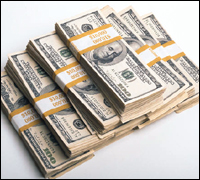The examples and perspective in this article deal primarily with the United States and do not represent a worldwide view of the subject.(December 2010) |


A currency card, cash strap, currency band, money band, banknote strap or bill strap is a simple paper device designed to hold a specific denomination and number of banknotes. [1] It can also refer to the bundle itself. [2]
Contents
In the United States, the American Bankers Association (ABA) has a standard for both value and color. Note that all bills greater than $2 only come in straps of 100 count. The colors allow for quick accounting, even when the bills are stacked, such as in a vault. Special striped bands are used for straps exclusively containing star notes.

